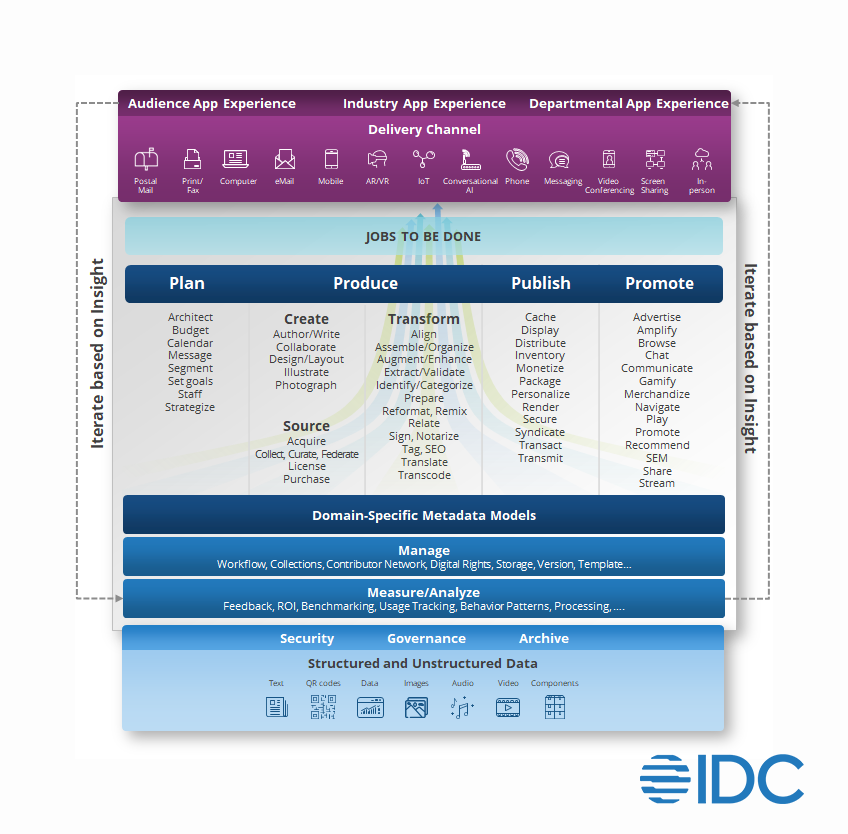It’s rapidly becoming apparent that digital transformation (DX) is not a finite destination, but rather a journey. Early DX initiatives were siloed and focused on short term gains. Organizations later scaled these initiatives across the enterprise, with a broader set of long-term goals, Today, organizations are looking at how they can leverage their digital capabilities for new value creation. This includes new operational efficiencies, how an organization engages with customers, how it attracts and retains employees, as well as new digital products and services. At IDC, we are calling organizations in this stage a “digital-first business”.
Because a digital-first business seeks to increase operational efficiency and productivity and improve both customer and employee experiences, these organizations need a new category of technology solutions for managing content. Cloud, artificial intelligence (AI), and new services-based architectures have made the legacy categories of capture, enterprise content management (ECM), content sharing and collaboration (CSC), digital asset management (DAM), and web content management (WCM) obsolete. In reality, these older labels refer to a set of use cases which are all supported by a common library of content services. These application categories made sense in the era of on-premises, standalone monolithic applications, but are cumbersome and inefficient in the context of the modern cloud and services architectures of the digital-first business.
Instead, IDC is proposing a new way to approach the content supply chain— a Unified Content Model that supports a common set of content-related services related to security, governance, archiving, measurement and analysis as well as the tasks to manage the supply chain stages shared by all content applications. The model also recognizes the need for sets of specialized services that may only apply to certain types of content or use cases. These services can be accessed and utilized via low-code/no-code tools to construct solutions for explicit jobs to be done that lead to specific business outcomes. In other words, the job to be done is separate from the supporting “plumbing” underneath. Solutions based on the Unified Content Model will orchestrate the content supply chain throughout the organization.
The Unified Content Model

The Unified Content Model has the following components:
- Interface to one or more data repositories – Repositories include structured and unstructured data, including text, image, audio, video, QR code assets and atomic componentized content.
- Measure/Analyze – A library of services to measure the usage and effectiveness of content. There is a closed feedback loop between measurements and the experiences that present jobs to be done.
- Manage – A set of services that are common to all use cases, including version control, templates, and permissions management.
- Domain–Specific Metadata Model – Common metadata that is shared across the content supply chain to facilitate interoperability, processing, and personalization.
- Plan, Produce, Publish, Promote – Categories that correspond to the “verbs” that describe actions performed on content as it traverses the supply chain journey. These are a set of services that may be chosen for a specific job to be done. These activities may be accomplished by a human, a machine, or both.
- Jobs to be Done – These are the content-centric activities that lead to specific business outcomes. Activities vary widely. Examples include
- Retain and dispose of documents correctly
- Execute non-disclosure agreement
- Collaborate for image review and approval
- Communicate quarterly financial results
- Update product pricing information
- Remove expired licensed materials
- Stream episodes at a virtual event
- Delivery Channel – Content may be delivered via a broad range of channels or edge devices – frequently delivered via more than one – depending on producer and consumer preferences. Content must be responsive and displayed in a manner that is appropriate for the channel.
- Experience – This layer describes the final recipient of the content. Note that recipients can be humans or technology.
- Audience App Experience – Consumption/usage by employees, partners citizens, patients, students, accountholders, and other end users
- Industry App Experience – Consumption/usage by industry users or applications, for example healthcare systems and portals, banking, or insurance policy systems
- Departmental App Experience – Consumption/usage by the business user or business application, such as enterprise resource management (ERP) or human capital management (HCM)
Benefits of the Unified Content Model
Why should an organization adopt a Unified Content Model? Solutions architected according to the model will increase operational efficiency by eliminating content silos and duplicative applications and/or platforms. This will afford several benefits to organizations:
- Enforce a common brand and company “voice”
- Support a 360-degree view of the customer
- Efficiency in content creation, management and reuse across solutions and applications
- Scale in using best in class cloud-based services
- “Future-proof” technology by making it easier to add or substitute services and delivery channels
- Improve the overall experience for both content producers and content consumers
What the Unified Content Model Means for Organizations
In IDC research early in 2022, 46% of respondents indicated that improving operational efficiencies is the top business objective for content services investments. Of course, organizations can’t scrap existing workflows and related solutions overnight, but as modernization initiatives progress, organizations should adopt the Unified Content Model as a blueprint for that modernization. We are seeing implementations of the model appear in the marketplace as technology vendors leverage the opportunities afforded by cloud computing and services-based architectures to redesign the content repository and open it up for interplay between systems and actions. The value for these vendors comes not from reproducing the “plumbing” of content management but rather in the expertise in tasks of the content supply chain, jobs to be done or applications at the edge.
How to get started? Begin by evaluating your current content-centric workflows, stakeholders and applications asking the following questions:
- What content is your organization creating and for what purpose? How much of that content is redundant (or worse, uncontrolled)? What content can be (or should be) reused and/or used for multiple purposes?
- Who is producing, reviewing, approving, delivering the content? In other words, who participates in the content supply chain? What actions must be performed on that content?
- How is that content updated, revised, retained, redistributed, disposed of?
- Who (or what) is consuming the content and when? Is similar content consumed at various stages of a relationship or supply chain? What integrations are required with other enterprise systems? What formats are required for delivery at each stage?
- How are you measuring the use and effectiveness of your content? Have you established a feedback loop? How do you know what is working and what is not?
Once you answer these questions, develop a plan to architect a solution that maximizes the storage, analysis, management and data descriptors of content based on the Unified Content Model with your developers, vendors and/or partners. Develop a migration and change management strategy to minimize disruption. Proceed down the path to greater content agility and becoming a digital-first business.
For more information on IDC’s research on unified content models, read our perspectives:
- Future of Customer Experience: Measuring Content Effectiveness to Reduce Customer Effort and Improve Customer Experience Satisfaction
- Market Analysis Perspective: Worldwide Enterprise Content Strategies, 2022
- Market Analysis Perspective: Worldwide Persuasive Content and Digital Experience Management Software, 2022
- Market Analysis Perspective: Worldwide and U.S. Intelligent Document Processing, 2022




